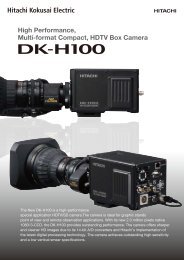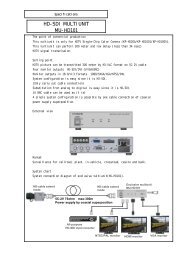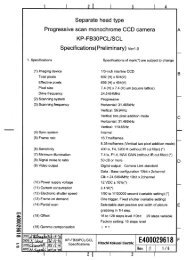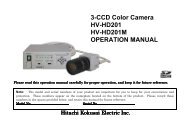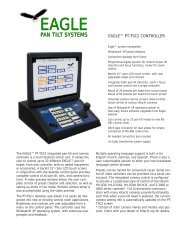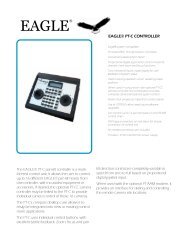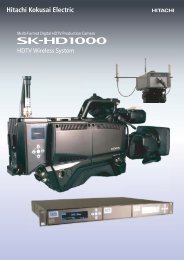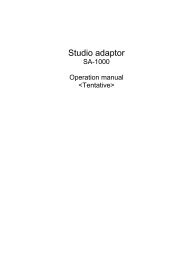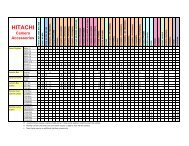REFERENCE GUIDE - Hitachi Kokusai Electric America, Ltd.
REFERENCE GUIDE - Hitachi Kokusai Electric America, Ltd.
REFERENCE GUIDE - Hitachi Kokusai Electric America, Ltd.
Create successful ePaper yourself
Turn your PDF publications into a flip-book with our unique Google optimized e-Paper software.
Note<br />
The modulation error ratio (MER) is a measure of the SNR in a digitally modulated<br />
signal. Like SNR, MER can be expressed in dB.<br />
Signal-to-noise (SNR or S/N) is an electrical engineering measurement, defined as<br />
the ratio of a signal power to the noise power corrupting the signal. Signal-tonoise<br />
ratio compares the level of a desired signal to the level of background noise.<br />
The higher the ratio, the less obtrusive the background noise is.<br />
• Status: Unlocked : will be displayed when any signal is received<br />
Locked : will be displayed when a signal is received<br />
At the bottom of the display the Constellation, FEC and Guard Interval will be shown<br />
automatically, if a signal is received and decoded by the receiver.<br />
• Guard: 1/4, 1/8, 1/16, 1/32 can be displayed depending on the bandwidth of<br />
the transmitted signal<br />
In COFDM, the beginning of each symbol is preceded by a guard interval. As long as the<br />
echoes fall within this interval, they will not affect the receiver's ability to safely decode the<br />
actual data, as data is only interpreted outside the guard interval.<br />
Longer guard periods allow more distant echoes to be tolerated. However, longer guard<br />
intervals reduce the channel efficiency. In DVB-T, four guard intervals are available (given<br />
as fractions of a symbol period): 1/32 ; 1/16 ; 1/8 ; 1/4<br />
Hence, 1/32 gives lowest protection and the highest data rate. 1/4 results in the best<br />
protection but the lowest data rate<br />
• FEC: 1/2, 2/3, 3/4, 5/6 can be displayed depending on the FEC of the transmitted<br />
signal<br />
Forward Error Correction (FEC) is a system of error control for data transmission, whereby<br />
the sender adds redundant data to its messages, also known as an error-correction code.<br />
This allows the receiver to detect and correct errors (within some bound) The advantage of<br />
forward error correction is that a back-channel is not required, at the cost of higher bandwidth<br />
requirements on average.<br />
Reference Guide: HITACHI Wireless Camera (HITACHI OEM Version)<br />
March 2010<br />
Page B





